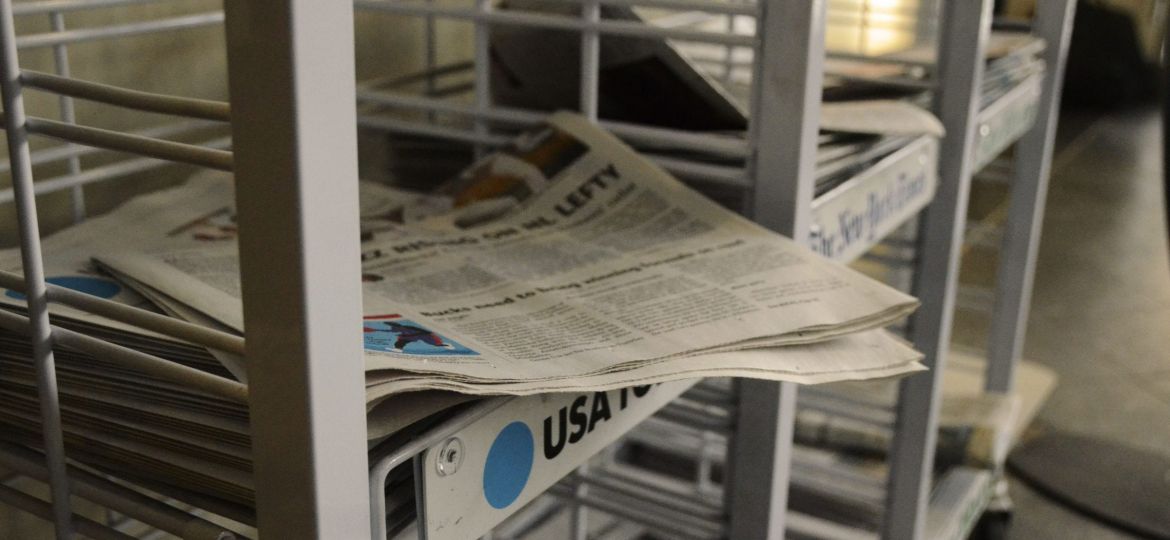
St. Olaf students may soon lose access to physical newspapers. While nothing is certain yet, St. Olaf’s Student Government Association (SGA) is strongly leaning towards cancelling the Collegiate Readership Program, which supplies students with the New York Times, USA Today and Minneapolis Star Tribune. The program would cease starting with the 2018-19 academic year.
SGA has proposed reallocating these funds to other “high impact student organizations” such as St. Olaf EMTs (SOEMT), The Greater Than Campaign and the Sexual Assault Resource Network (SARN). However, the savings from the Collegiate Readership Program, which costs $28,000 a year, could benefit other organizations as well. While the reallocation hasn’t been confirmed yet, there is a strong likelihood that the Collegiate Readership Program will not be funded next year.
SOEMT was the first organization to approach SGA in regards to their budget, after facing inconsistent yearly budgets. This meeting encouraged SGA to reconsider where their money was being spent and to look for more efficient uses, which led them to question the Collegiate Readership Program.
“We had a question of if we were going to get our budget which is problematic,” SOEMT’s president Madeleine Wagner Sherer ’18 said. “We need to be able to pay for the medical supplies.”
Most students and organizations first heard about this reallocation when Student Government Association Chief Financial Officer Justice Nwigwe ’18 sent out a survey asking for student opinions on the program.
For SARN this information came as a shock.
“We weren’t notified that there was going to be a reallocation of funds,” Addie Hakes ’18, co-chair of SARN, said. “So it was kind of weird when we got that email about the Collegiate Readership Program being defunded and the funds were going to go to high impact organizations.” SARN was approached by SGA in the beginning of the year to discuss their budget, but never formally met.
However, Hakes is nervous about the reliability of the funds.
“With them not involving us, how much accountability do they then have to follow through on the allocation of those funds to SARN? We don’t want to get our hopes up for something that might not happen the way it’s said it’s going to be,” Hakes said.
However, SARN is already thinking about how they could use the money.
“It’s a really big opportunity to bring in outside resources: a lot more speakers, a lot more classes, and hearing from professionals and people outside of campus about sexual violence and prevention,” Hakes said.
SOEMT’s treasurer, Jon Vajgrt ’18, has been involved in the funding process with SGA. SOEMT is hoping to eventually become independently funded. However, like SARN, SOEMT was unaware of where the funds would come from until Nwigwe’s email was sent out.
“Initially we were just told that we would become a line-item,” Sherer said. “Then we were told that this might be in conjunction, like a fund, with other high impact organizations such as SARN. I kind of found out when the survey came out actually about the reallocation of funds. We weren’t aware of that.”
SOEMTs require a large budget due to the single use of their supplies.
“There’s not a lot of flexibility that we can have in our budget,” Sherer said. “We always have to restock all of our medical supplies. Things like bandaids, bandages, ace wrap, SAM splints, those kinds of things have to be replaced every year. Those kinds of expenses have to be covered each year.”
SOEMTs also have long term costs that need to be covered, including radios, replacement bags, uniforms and updated, larger equipment, such as CPR manikins.
Despite possibly ending the Collegiate Readership Program, the St. Olaf community will not lose full access to popular news outlets. Digital access to the New York Times and other papers is already available through St. Olaf’s library.
bade1@stolaf.edu

